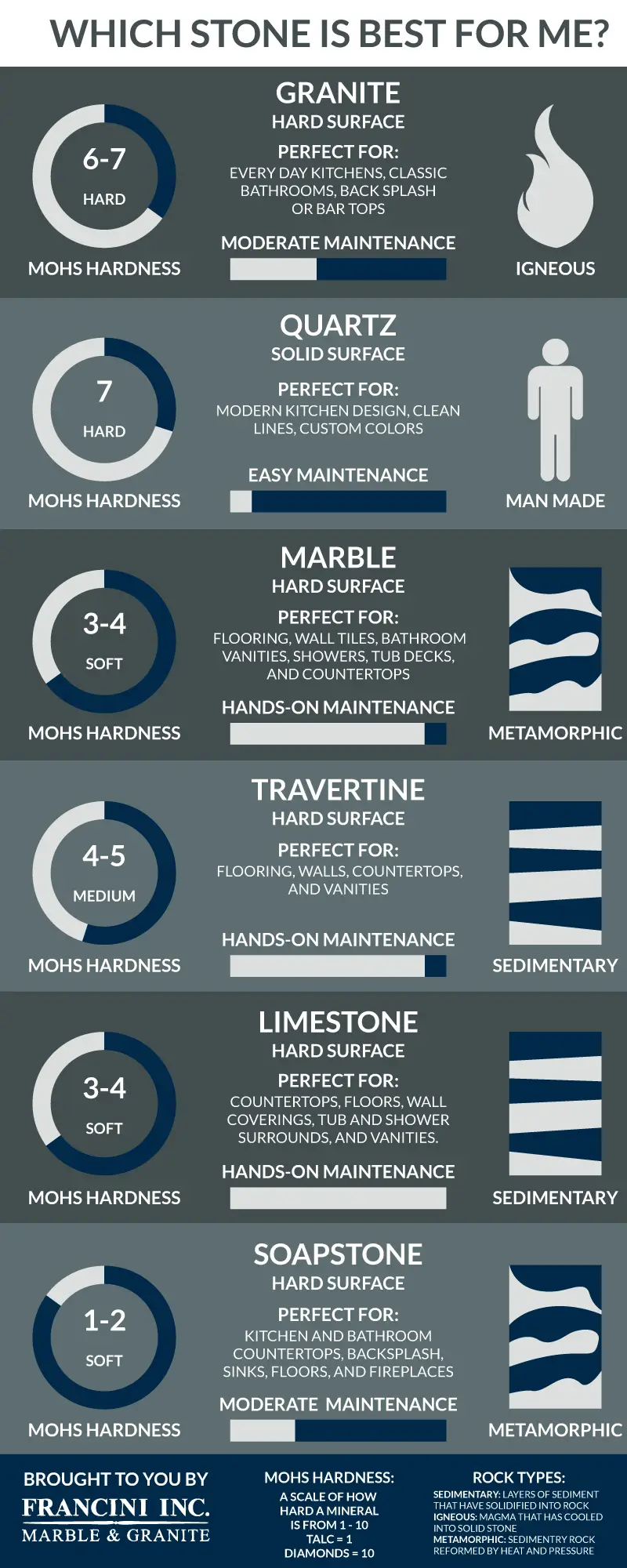When remodeling your kitchen or bathroom, it’s important to consider what sort of stone you want to use where as one of your first steps. However, the sheer amount of options can be overwhelming, making it vital to consider all of the factors that accompany each type of stone.

Granite
- Hard Surface
- Perfect for: Everyday kitchens, classic bathrooms, back splashes or bar tops.
- Moderate Maintenance
- Hardness: 6 - 7 on Mohs' scale
- Igneous Stone
Quartz
- Solid Surface
- Perfect for: Modern kitchen design, clean lines, custom colors.
- Easy maintenance
- Hardness: 7 on Mohs' scale
- Manmade
Marble
- Hard Surface
- Perfect for: Flooring, wall tiles, bathroom vanities, showers, tub decks, and countertops.
- Intensive Maintenance
- Harness: 3-4 on Mohs' scale
- Metamorphic
Travertine
- Hard Surface
- Perfect for: Flooring, walls, countertops, and vanities.
- Intensive Maintenance
- Hardness: 4-5 on Mohs' scale
- Sedimentary
Limestone
- Hard Surface
- Perfect for: Countertops, floors, wall coverings, tub and shower surrounds, and vanities.
- Intensive Maintenance
- Hardness: 3-4 on Mohs' scale
- Sedimentary
Soapstone
- Hard Surface
- Perfect for: Kitchen and bathroom countertops, backsplashes, sinks, floors, and fireplaces.
- Moderate Maintenance
- Hardness: 1-2 on Moh's scale
- Metamorphic
Technical Terms
Mohs' scale of hardness is a scale of 1-10 that geologists use to classify the hardness of a mineral. The rating on the scale is based on which minerals are capable of scratching each other. Diamonds are a 10, Talc is a 1, and your fingernail is about a 2. The lower the number on Mohs' scale, the easier it is to scratch.
Every rock is classified into three different types of stone, depending on how they were formed. Sedimentary rocks are created by layers of soil and silt compacting on top of eachother until they create a sort of concrete. They often have a layered effect, common examples include limestone and sandstone.
Igneous rocks are created when liquid rock (also known as magma) solidifies into a chunk of rock. Depending on the nature of the magma and the rate it cooled at, this can produce various effects, between smooth dark rock like basalt, or a collection of hard crystals like granite.
Metamorphic rocks combine the best of both world by taking pre-existing rocks and reforming them under extreme heat and pressure under the earth's crust. This process forms new minerals out of the old ones and creates swirled textures by buckling the stone. Good examples include marble and slate.